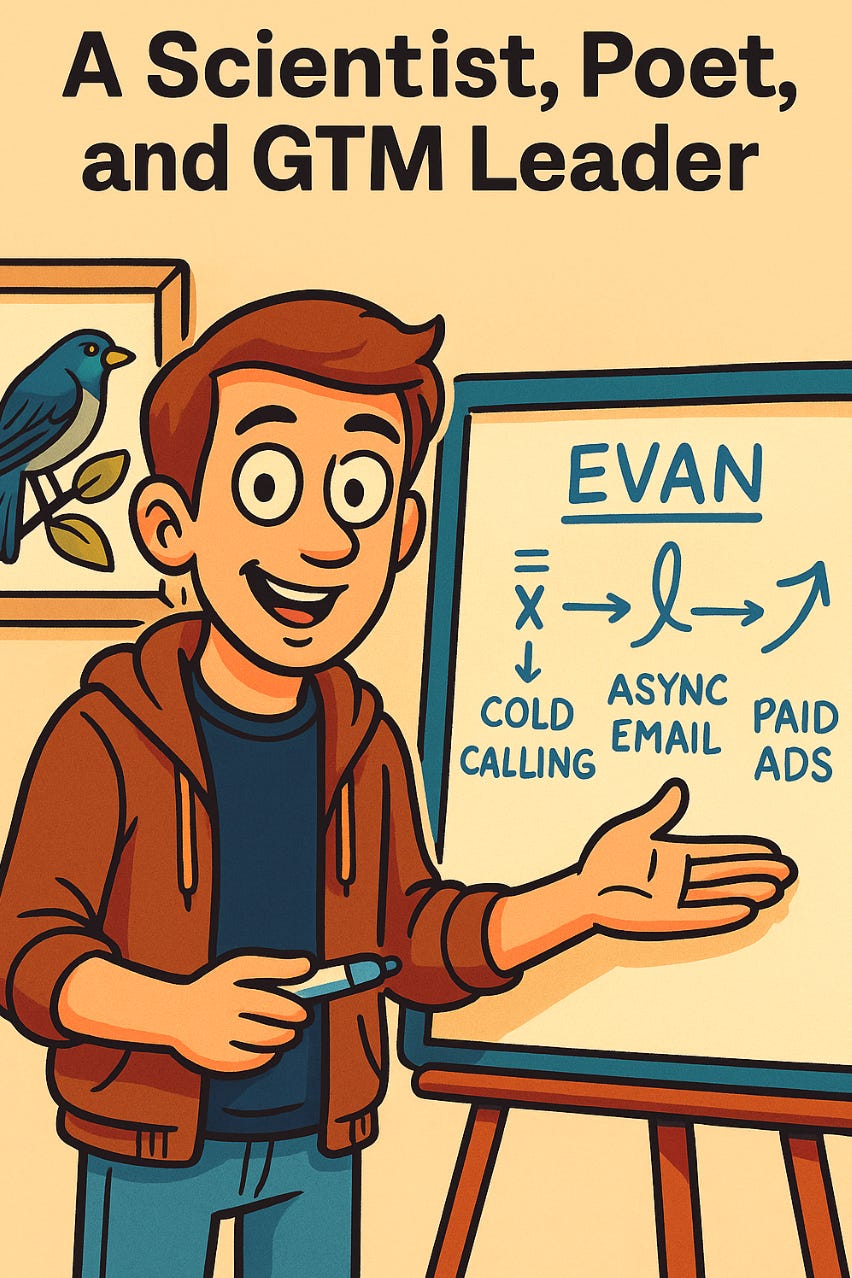How to think like a poet to validate new GTM experiments
Combine a poet’s clarity, a scientist’s rigor, and a GTM leader’s speed to rapidly test new initiatives
"Every new product, market, or region is an experiment. Your job is to test fast, learn faster, and find out what works."
— Evan Dunn, Head of Growth at Pixis
A poet, a scientist, and a GTM leader walk into a bar. . .
That’s Evan Dunn all rolled into one.
Evan Dunn is a true Renaissance Man. A poet, a linguist, former VP of Product, and a GTM leader who coined the phrase, “Always Be Experimenting”. He currently leads growth at Pixis and serves as the Chief Scientist at Punch GTM.
He explained his simple framework for quickly testing go-to-market ideas.
Here’s his straightforward approach:
Step 1: Cold Calling
Why cold calling first?
“One good conversation beats ten shallow email replies. Start by calling people, collect real feedback, find what works, then scale.” - Evan
You get clear feedback from real conversations.
Quickly test if there’s actual interest and refine your customer profile.
Real example:
At Airwallex, Evan tested 8 industries by calling qualified leads (from Phone Ready Leads, now TitanX.io). In four months, they found three industries worth pursuing, and were booking 5 meetings a day consistently. They focused on these, effectively narrowing their GTM strategy.
Step 2: Email and LinkedIn
After refining ideas with calls:
Use call insights to shape your email and LinkedIn outreach.
Run quick tests, adjusting your messaging based on the responses.
Step 3: Account-Based Marketing (ABM) and Ads
Once you've confirmed what works:
Target validated segments with focused ads and ABM.
Only scale up with broader marketing activities once you have clear evidence.
How Pixis Ran This Framework
Goal: Find out who exactly they should be targeting
Tools they used:
LinkedIn Sales Navigator
Phantom Buster
Clay (for data and AI research)
Salesforce
Frontspin (for calling)
Upcell.io (for mobile data)
TitanX.io (for phone validation)
Exactly what they did:
1. Defined target groups:
Created LinkedIn Sales Navigator lists for “Marketing Leaders” (Director and above) and “Marketing Managers.”
2. Extracted and enriched data:
Scraped the lists with Phantom Buster.
Cleaned and segmented the data using Clay’s AI tools.
3. Integrated data into CRM:
Uploaded the cleaned data to Salesforce, clearly marking each person’s segment.
4. Made cold calls:
Used Frontspin software to manage calling.
Calls focused on gathering insights (customer problems, current solutions, buying behavior) and booking meetings.
5. Analyzed call data:
Tracked important metrics: connection rates, completed conversations, meetings booked.
Used AI to analyze call notes and recordings for clear patterns.
6. Iterated based on feedback:
Continuously adjusted their messaging, target lists, and email/LinkedIn outreach based on what they learned.
Results:
Quickly found segments that were ready to buy, based on real conversations, not guesses.
Allowed them to efficiently target these segments with ABM and paid advertising.
A word from our sponsor. . .
You’ve been following our journey to execute unconventional GTM experiments for the top of funnel. Now, we are replicating those processes to solve mid-funnel challenges by predicting intent and loyalty at the individual level.
Do you have ~5 min to fill out this survey to help inform our product roadmap and build benchmarks for mid-funnel?
How to nurture window shoppers into loyal customers
You don't have a lead generation problem; you have a lead nurture problem.






